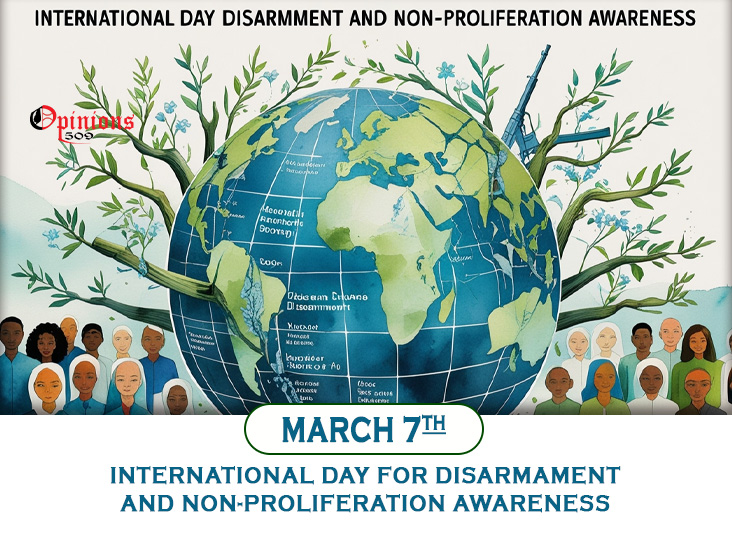The International Day for Disarmament and Non-Proliferation Awareness, observed annually on March 5th, stands as a testament to the global commitment towards a safer and more secure world. In the face of increasing geopolitical tensions, the importance of disarmament and preventing the spread of weapons of mass destruction cannot be overstated. This day serves as a reminder of the urgent need for nations to come together, transcend differences, and work toward a future free from the threat of devastating weaponry.
Table of Contents
- 1 I. The Genesis of International Day for Disarmament and Non-Proliferation Awareness
- 2 II. The State of Global Disarmament Efforts
- 3 III. Challenges in Contemporary Security Landscape
- 4 IV. Role of International Organizations and Civil Society
- 5 V. Bridging Divides: Diplomacy and Dialogue
- 6 VI. Future Prospects and Recommendations
- 7 Conclusion
I. The Genesis of International Day for Disarmament and Non-Proliferation Awareness
A. Historical Context
To comprehend the significance of this international observance, it is essential to delve into its historical roots. The idea of disarmament has been a recurring theme in international relations since the aftermath of World War II. The devastation caused by nuclear weapons in Hiroshima and Nagasaki prompted the global community to recognize the need for collective action to prevent such horrors from recurring.
B. Establishment of the International Day
The United Nations (UN) has been at the forefront of efforts to promote disarmament and prevent the proliferation of weapons of mass destruction. The International Day for Disarmament and Non-Proliferation Awareness was officially established by the UN General Assembly in 1978 through Resolution 32/40 B. This resolution aimed to foster a global awareness of disarmament and encourage member states to engage in dialogue and cooperation for the common goal of a world without the looming threat of destructive weaponry.
II. The State of Global Disarmament Efforts
A. Nuclear Disarmament
Nuclear Arms Reduction Treaties
Over the decades, various international treaties and agreements have been negotiated to curb the proliferation of nuclear weapons. The Treaty on the Non-Proliferation of Nuclear Weapons (NPT), signed in 1968, remains a cornerstone of global efforts to prevent the spread of nuclear weapons. Additionally, strategic arms reduction treaties between nuclear-armed states have played a crucial role in limiting the number of deployed nuclear weapons.
Challenges and Roadblocks
Despite these efforts, challenges persist in achieving meaningful progress towards nuclear disarmament. The reluctance of some nuclear-armed states to fully commit to disarmament raises concerns. The development of new and advanced nuclear weapons technologies further complicates the landscape, necessitating renewed diplomatic efforts and a commitment to multilateral cooperation.
B. Conventional Weapons and Small Arms
Conventional Arms Treaties
Beyond nuclear weapons, conventional arms and small arms also pose significant threats to global peace and security. International treaties like the Arms Trade Treaty (ATT) aim to regulate the trade of conventional arms and prevent their illicit transfer. The effective implementation of such treaties requires the cooperation of nations and a shared commitment to transparency and accountability.
Humanitarian Impact of Conventional Weapons
The humanitarian impact of conventional weapons, especially in conflicts involving non-state actors, underscores the need for comprehensive disarmament efforts. Landmines, cluster munitions, and other indiscriminate weapons continue to cause civilian casualties long after conflicts have ceased. Addressing the human toll of conventional arms requires not only disarmament measures but also humanitarian assistance and post-conflict reconstruction efforts.
III. Challenges in Contemporary Security Landscape
A. Emerging Technologies
The contemporary security landscape is marked by the emergence of new technologies that pose challenges to traditional disarmament efforts. The development of autonomous weapons, cyber warfare capabilities, and artificial intelligence in military applications introduces complexities that demand innovative and adaptive approaches to disarmament.
B. Regional Conflicts and Proliferation Risks
Ongoing regional conflicts and geopolitical tensions contribute to the risk of weapon proliferation. The volatile situations in the Middle East, North Korea’s nuclear ambitions, and territorial disputes in various regions underscore the need for sustained diplomatic efforts to address root causes and promote regional stability.
IV. Role of International Organizations and Civil Society
A. United Nations and Disarmament Initiatives
The United Nations plays a central role in coordinating global efforts towards disarmament. Through its various agencies and committees, the UN facilitates dialogue, monitors compliance with disarmament treaties, and promotes confidence-building measures among nations. The UN’s Disarmament Commission and the Conference on Disarmament serve as key forums for multilateral negotiations and discussions.
B. Civil Society and Grassroots Movements
While international organizations play a crucial role, the engagement of civil society is equally vital in promoting disarmament awareness. Grassroots movements, non-governmental organizations (NGOs), and advocacy groups contribute to shaping public opinion, holding governments accountable, and fostering a culture of peace. The International Campaign to Abolish Nuclear Weapons (ICAN), recipient of the 2017 Nobel Peace Prize, exemplifies the impact of civil society in advancing disarmament goals.
V. Bridging Divides: Diplomacy and Dialogue
A. Multilateral Diplomacy
The essence of disarmament lies in multilateral diplomacy, where nations engage in dialogue and negotiation to build trust and consensus. Multilateral forums such as the Conference on Disarmament provide a platform for states to discuss disarmament issues, share perspectives, and work towards common solutions. The success of these diplomatic endeavors hinges on the commitment of nations to prioritize collective security over individual interests.
B. Confidence-Building Measures
Building trust among nations is a fundamental aspect of disarmament efforts. Confidence-building measures, including transparency in military capabilities, joint inspections, and information sharing, contribute to reducing suspicions and fostering an environment conducive to disarmament. The Open Skies Treaty and the Comprehensive Nuclear-Test-Ban Treaty (CTBT) exemplify mechanisms aimed at building confidence and preventing clandestine activities.
VI. Future Prospects and Recommendations
A. Strengthening International Treaties
To advance the cause of disarmament, nations must reaffirm their commitment to existing international treaties and agreements. Efforts to strengthen the NPT, ensure the full implementation of the ATT, and promote adherence to the CTBT are essential in creating a robust framework for disarmament.
B. Embracing New Technologies Responsibly
As emerging technologies reshape the nature of warfare, nations must navigate the ethical and security implications responsibly. International norms and regulations regarding the use of artificial intelligence in military applications, autonomous weapons, and cyber warfare need to be developed to prevent unintended consequences and maintain global stability.
C. Addressing Root Causes of Conflict
Disarmament efforts should not be isolated from addressing the root causes of conflict. Socioeconomic inequalities, political grievances, and ethnic tensions often fuel conflicts, leading to arms build-ups. A holistic approach that combines disarmament initiatives with conflict prevention, peacebuilding, and development can contribute to sustainable peace.
D. Empowering Civil Society and Education
Empowering civil society through education and advocacy is crucial in creating a groundswell of support for disarmament. Educational programs that highlight the humanitarian consequences of weapons and promote a culture of peace can shape the attitudes of future generations. Governments should actively engage with civil society and include diverse perspectives in disarmament discussions.
Conclusion
The International Day for Disarmament and Non-Proliferation Awareness serves as an annual reminder of the collective responsibility to build a world free from the threat of weapons of mass destruction. While progress has been made over the years, significant challenges persist in the contemporary security landscape. The path forward requires renewed diplomatic efforts, responsible use of emerging technologies, and a commitment to addressing the root causes of conflict.
As nations grapple with geopolitical tensions and regional conflicts, the call for global unity becomes even more pressing. By prioritizing dialogue over confrontation, transparency over secrecy, and cooperation over competition, the international community can pave the way for a future where the specter of devastating weaponry no longer looms over humanity. The journey towards disarmament is a shared responsibility that demands unwavering commitment, collaboration, and a vision of a world where peace prevails over the destructive forces of war.
Author
Stay connected for new publications, events, and more.







More Stories
World Health Day: A Global Commitment to Health and Well-being
International Day of Conscience: Cultivating Global Harmony Through Ethical Awareness
La Journée mondiale de la vaccination : Un Engagement pour la Santé Mondiale